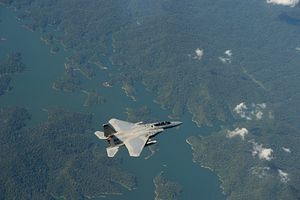What does the campaign against ISIS tell us about the future of airpower, and about the ability of the United States to tack between East Asia and the Levant?
We don’t have anything close to a full appreciation of how the war against ISIS will play out. American officials continue to insist that, the fall of Ramadi notwithstanding, the air campaign has significantly degraded ISIS’s military capabilities, slowing or stopping its advance in many parts of the country and opening the door to the liberation of areas such as Tikrit. And Iraqi offensives over the next few weeks may roll back ISIS gains, which would reflect a very different picture of reality than the one now apparent.
But it nevertheless remains apparent that ISIS can plan, prepare for, and execute offensive operations while under threat from U.S. airpower. In both Iraq and Syria, Ramadi has captured territory defended by government forces, even as the U.S.-led coalition have attacked its fielded forces and its logistical infrastructure. The Islamic State does not appear ready to collapse, and neither Iraqi nor Syrian government forces seem ready to expunge it.
The course of the campaign indicates, perhaps, that irregular forces are successfully adjusting to what became known as the Afghan Model. To recap, the Afghan Model (built on the success of U.S. operations against the Taliban in the fall and winter of 2001) suggested that a combination of precision airpower, special operations forces, and local proxies could win wars against reasonably formidable opponents without the deployment of large ground formations.
To be sure, operations against ISIS have lacked one element of the Afghan Model; special operations forces forward deployed as part of an offensive spearhead. But then Operation Inherent Resolve shouldn’t need them; Iraqi government forces really should be more capable of spearheading a combined air-ground offensive than the makeshift militias that emerged in Benghazi or Misrata, or even than the fighters of the Northern Alliance. The difference (already apparent in the Taliban’s successful offensive in Afghanistan) seems to lie with insurgent tactics; ISIS has simply learned effective ways of mitigating the airpower advantage of the U.S. and its allies.
More broadly, the extent of the campaign indicates that what airpower theorists like to call the “inherent flexibility of airpower” cannot resolve the major resource issues associated with the pivot (or, if you prefer, the rebalance). Implicit in the rebalance is the idea that the United States can still use airpower, and long range naval strike, to solve security problems around the world, even as it focuses the bulk of its efforts on managing China. If fighting a group as small as ISIS requires a long-term commitment of U.S. power, with attendant demands on allies and infrastructure, then the logic underpinning the pivot begins to unravel. This is especially the case if the United States cannot escape the political pressures that continue to draw it into Europe and the Middle East.

































